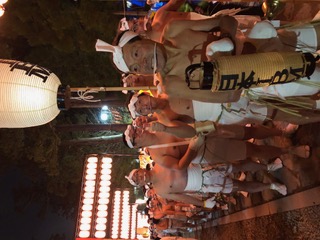Rituals and Stability
- At January 14, 2020
- By admin
- In Annes Letters
 0
0
Dear Family and Friends,
Why do rituals both disturb and reassure? Are they designed to awaken parts of ourselves that we might not want to see, yet at the same time offer a stabilizing familiarity? Probably both, maybe neither.
The Japanese are renowned for their love of order and predictability. Even when the world seems to be disintegrating before our very eyes, within our very hearts, the Japanese have ways that seem to hold things together. There is the exact timing of the bullet trains, for example, which run to the second. Or the precise dates of natural phenomena, such as the progressive arrival of cherry blossoms from south to north.
Listening to the news, I am often pulled apart by the dangerous, far-reaching choices of only a few world leaders or the devastating consequences of climate change. I wonder where we are headed. And more importantly, I ponder what can unify us, both as a group and as individuals worldwide.

January 14 is Dontosai, a New Year’s ritual here in Japan. It is based on fire, on burning the old to purify the new. It demands challenges of fending off the cold, of walking through the city scantily clad, shivering, carrying lanterns, ringing bells, winding one’s way to shrines for warmth and blessing.

It is important that company members join this ritual, this test of strength, this demand to put group cohesiveness over individual comfort and desire. And people come, year after year. Groups join to be tested and purified. Individuals come to pray, to hope for a year of good fortune and of luck.

It is a happy ritual. It challenges, yes, but also reassures. It draws our hearts and minds to an intangible center that is cohesive and eternal. This ritual reminds us that no matter what is going on in the world, there is a place, a condition where there is peace and trust, stillness and an infinite sense of belonging. What more could we ask in this age of upheaval and ever increasing distrust?
Love,
Anne
Why do rituals both disturb and reassure? Are they designed to awaken parts of ourselves that we might not want to see, yet at the same time offer a stabilizing familiarity? Probably both, maybe neither.
The Japanese are renowned for their love of order and predictability. Even when the world seems to be disintegrating before our very eyes, within our very hearts, the Japanese have ways that seem to hold things together. There is the exact timing of the bullet trains, for example, which run to the second. Or the precise dates of natural phenomena, such as the progressive arrival of cherry blossoms from south to north.
Listening to the news, I am often pulled apart by the dangerous, far-reaching choices of only a few world leaders or the devastating consequences of climate change. I wonder where we are headed. And more importantly, I ponder what can unify us, both as a group and as individuals worldwide.

January 14 is Dontosai, a New Year’s ritual here in Japan. It is based on fire, on burning the old to purify the new. It demands challenges of fending off the cold, of walking through the city scantily clad, shivering, carrying lanterns, ringing bells, winding one’s way to shrines for warmth and blessing.

It is important that company members join this ritual, this test of strength, this demand to put group cohesiveness over individual comfort and desire. And people come, year after year. Groups join to be tested and purified. Individuals come to pray, to hope for a year of good fortune and of luck.

It is a happy ritual. It challenges, yes, but also reassures. It draws our hearts and minds to an intangible center that is cohesive and eternal. This ritual reminds us that no matter what is going on in the world, there is a place, a condition where there is peace and trust, stillness and an infinite sense of belonging. What more could we ask in this age of upheaval and ever increasing distrust?
Love,
Anne



